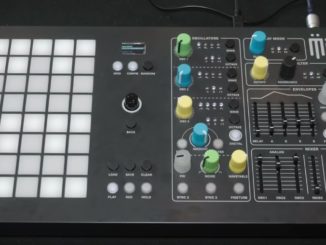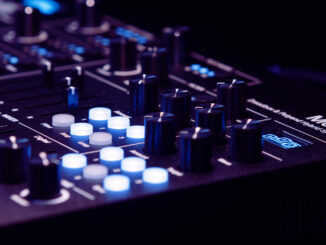Polyend Synth is a new portable multi-engine polyphonic digital Synthesizer with granular that aims to simplify multi-timbral playability.
Playing a multi-timbral Synthesizer is usually a somewhat tricky undertaking. You can either have a MIDI keyboard that splits into several MIDI zones, a multi-channel sequencer, or you go via the DAW detour.
Multi-timbral synthesizers can also be very playful and hands-on. Polyend shows this with their end-of-the-year surprise Synth.
Polyend Synth
Synth, a very original name, is a digital Synthesizer that tries to offer multitimbrality playfully. Instead of plastering musicians with tricky MIDI layer/zone settings from the first seconds, Polyend decided to embed the synth into a grid-based pad interface with three zones.
Using the new Smart Grid feature, you can load a Synthesizer engine into each of them and play it independently with the pads. For example, an arpeggiator/sequencer in the first, a pad sound in the second, and a lead or bass in the third.
This allows you to play three sounds simultaneously on a portable device with full expressivity using the polyphonic aftertouch pads. Each zone also has its own independent customizable 64-step sequencer or 14-type arpeggiator that responds to your playing in real time and various chord modes, giving you another level of expressivity.
The chord mode is intriguing. According to Polyend, you can set two engines to “followers,” which adjust their notes according to the current chord.
Scale locks help maintain musicality by keeping everything within a set scale, while the followers continue to adapt to changes even when using chord packs drawn from multiple scales—an exciting playing concept.
Piotr Raczyński, founder of Polyend, says: “Our goal was to develop a device that merges complexity with true playability. Synth is designed for musicians who want an accessible but sonically rich experience.”
Multi-Engine
Polyend Synth is not only multi-timbral but also has a multi-engine in its core, so it is a true multi-synth. It has eight unique synth engines, covering many traditional and more experimental synthesis techniques.
The multi-engine has a maximum of eight voices for the entire Synthesizer, which is a bit low for 2024. In my opinion, 16 or 24 would have been better. The eight voices can be flexibly distributed across the three zones. Let’s talk now about the engines.
Number one is called PHZ and draws inspiration from the 1985 Casio CZ-101 Synthesizer. The engine follows the same synthesis ideas but offers new physical distortion algorithms, allowing you to craft all new sounds.
Then, you can explore the ACD engine, a Roland SH-101-influenced synth engine that brings acid-flavored timbres to the Polyend Synth. The VAP engine makes rich analog-like polyphonic sounds possible with the warmth of the Sequential Circuits Prophet 6.
Wavetables are omnipresent these days, and they are also present in the new Polyend Synth. The WAVS engine hosts two oscillators with custom wavetables and a retro mode for vintage-inspired aliasing.
Next is the WTFM, which fuses wavetables into an FM engine, resulting in a wide range of mellow to metallic sounds. Two more engines follow a more experimental route.
First, PMD is a physical modeling synth with roots in Mutable Instruments’ open-source module codes, Elements and Rings. With air, bow, and strike parameters, you can craft your own acoustic-like tones. According to Polyend, it uses the MI code, but they expanded it with new features.
Besides PMD, you also get a customizable granular engine (GRAIN) with user-loadable samples and a unique burst mode for rhythmically synced grain production. It was clear that it had to be granular, as it has been the hot topic in hardware for 1-2 years.
Each of these engines offers a variety of parameters that allow you to delve deeply into them.
Sound Shaping
Once you have crafted your sound with the selected engine, you can shape the signal further with a multimode filter (4-pole lowpass/highpass/bandpass and 2-pole notch), an ADSR envelope, and LFO per zone.
All three zones are then routed to a mixer with an independent pan, mix, and three effect amount controls. Yes, Polyend Synth has a three-slot global multi-FX processor, each with classic and unique modes: modulation, delay, and reverb.
For example, the reverb has a warp mode, which is excellent; you can save the settings in user presets. Talking about presets. All these settings, including patches, macros, grid settings, and effects, are instantly recallable in shareable scenes.
Connectivity
On the back, you have a 3.5mm stereo output, MIDI in/out on a type B minijack, a microSD card slot for samples, a USB-C port for power with a dedicated button. The USB-C port requires 5V 1A, so you can also use a power bank for mobile use. Unlike the Play+ or Tracker+, there is no USB audio.
Polyend Synth First Impression
An exciting new multi-timbral multi-engine Synthesizer. It’s great that it covers almost everything in synthesis in a portable format, including more experimental ones like granular and physical modeling. I also find the idea of offering multitimbrality in a more playful way interesting.
The 8-voice limitation is a downer for me. For 2024, it’s a bit weak, especially given the unit’s plethora of synthesis options. Maybe future firmware updates can squeeze more out of it. Either way, it’s an attractive, very surprising release from Polyend. And it’s good that they’re back in the pure Synthesizer area.
Polyend Synth is available now for $499/499€ at select retailers and through Polyend’s website.
More information here: Polyend
Available at my partner








I’m not the biggest fan of Polyend’s (or anyones) “Big Ol’ Grid Of Tiny Colored Buttons” interface but a $500 multi-timbral synth feels like a nice middle ground between an overly elaborate expensive sequencer and something like a Novation Mono Station.
My hardware workstation has 16 individual MIDI channels on a scene, 16 swappable scenes per save file. Controlling each synth section via MIDI is appealing to me in a live scenario. I’m gonna keep an eye on this and wait until the public gets their hands on it. If all the influencers are pushing it, i’m definitely waiting. G.A.S. bubbles eventually burst. ;]
After this company releases and abandons projects after only a year or 2 makes me extremely wary to buy anything new
Unfortunately, exactly this. Got burned with the OG Play, which just now got the MIDI Performance mode, but in the end their devices are what they are: toys. Nice to noodle around with them, but not really designed to work with other stuff. Sold the Play at replaced it with Playbeat, which basically does the same, has obviously better sample file handling and costs almost nothing. More fun on the iPad, where you can touch it. This one here: “Three synths at the same time” does not sound like they solved a real “problem”. You can do this with a Launchpad as well, btw. Get the Pro MK3, buy a few VSTs and you have spent less for more. Also (and I know, I’m not the first): Polyend Synth+ coming in one year. Gets abandoned in three years (just look at their older lineup).
Looks like a new playful approach with different engines to play on the coloured pad zones. As you said. Very interesting. But also limitations. Built in battery would have been exiting. Also USB Audio.
A cheaper alternative is the Novation Tracks. It’s also mature, which none of Polyend’s products ever are. I know. The colored pad zones playability looks like a gimmick, which will get old pretty quick, but that’s just me. And I replaced all my keyboards with a Launchpad btw.
Tracks is great and underrated.agree that zone playing looks fun but its more a gimmick
This looks great, I love the grid based way of making music and this multi zone way of playing multitimbral is inspired. My one gripe would be that it only has stereo out. Even if it did have multichannel usb out that would be better than just stereo.
Polyend doing their thang, after all. Audio over USB sounds like a no-brainer in 2024, which even the Play+ got only as a neutered version. Hell, Dreadbox just delivered it via a Software update and it works beautifully (yes, yes, it’s a mono synth, but then again, even USB2 has bandwidth for any synth for ages). I dream of a future, where you don’t need to fuzz around with analog cables and just use USB, but there are audio devices, pedals to be sold. Also, the vintage crowd needs their crumbling gear to connect 😉
Meh, I’ll pass, 8 channels, no automation…
three zones/channels with in total 8 voices not 8 channels 😉
Thanks for the correction, you’re quite right 😁
So you say, I can finally play my famous 2 2/3 chords, if I use all three zones? 😉 They really did something unique here…
Not worth the plastic it is printed with.
They will release this and then in 12-18 months they will abandon it and move to something else. This company has great ideas but never seem to fully follow through and finish the products life cycle. I sold my Polyend Seq because there were still so many bugs and they just flat out stopped with the updates. They aren’t ever getting my money again.